The article provides a global analysis to model patterns of current and future language endangerment. In other words, it’s trying to explain and predict where and how language loss happens, by measuring stuff.
Interesting excerpts of the article:
Our best-fit model explains 34% of the variation in language endangerment (comparable to similar analyses on species endangerment.
That’s actually rather good, considering the global scale of analysis for something as messy as human beings, and how local political factors can revive or kill languages.
Five predictors of language endangerment are consistently identified at global and regional scales: L1 speakers, bordering language richness, road density, years of schooling and the number of endangered languages in the immediate neighbourhood.
I feel like linguists handling minority languages should already know thing by “gut feeling”: small community, with lots of nearby languages, well-connected to other communities, being drilled by the government = threatened linguistic community. However, it’s still great that the article is grounding that “gut feeling” into data.

